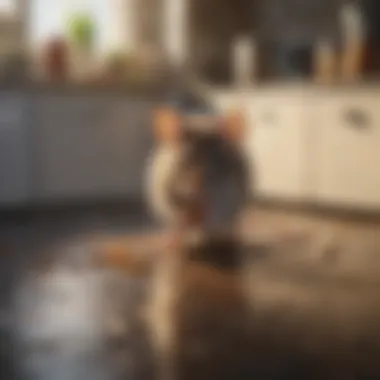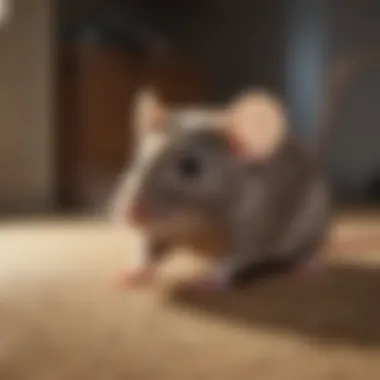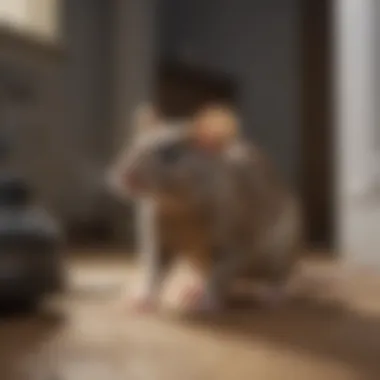Effective Steps to Take When You See Mice in Your Home


Intro
Encountering mice in your home can be a disconcerting experience. It might seem like a small issue at first, but a few sighted mice can become a colony quickly. Understanding how to identify these pests, the signs of an infestation, and effective ways to manage the situation is essential for homeowners. This guide provides practical steps to take, focusing on safety and long-term solutions to eliminate the problem.
Pest Identification
Identifying the type of pests is a crucial first step in managing an infestation effectively. The most common mice found in homes are the house mouse (Mus musculus) and the deer mouse (Peromyscus maniculatus). The house mouse typically has a grayish-brown fur, large ears, and a pointed snout. It measures about 3 to 4 inches long, excluding its tail, which is equally long.
The deer mouse, on the other hand, is more variable in color. It usually has a brown upper body and white underbelly with large eyes. It can also be slightly larger than the house mouse, measuring about 4 to 5 inches in body length.
Signs and Symptoms of Infestations
Several signs can indicate a mouse infestation in your home. These signs include:
- Droppings: Mice leave droppings about the size of a grain of rice, usually near food sources.
- Nesting materials: Shredded paper, fabric, or insulation can be a sign of nesting.
- Gnaw marks: Look for signs of gnawing on food packaging, furniture, or walls.
- Noises at night: Mice are nocturnal and often make scratching or squeaking sounds during the night.
Additionally, you may find footprints in dusty areas or grease marks along baseboards where mice frequently travel.
Prevention Strategies
Preventing mice from entering your home is far more manageable than dealing with an established infestation. Here are key strategies you can implement:
- Seal Entry Points: Inspect your home for any cracks or openings, particularly around windows, doors, and foundations. Use materials like steel wool or caulk to seal these gaps.
- Maintain Cleanliness: Keep food in sealed containers and maintain a clean kitchen. Food spills and crumbs can attract mice.
- Reduce Clutter: A cluttered home can provide ample hiding spots for mice. Regularly declutter areas like attics or basements.
Natural Deterrents and Barriers
Several natural deterrents can help keep mice at bay. Consider these options:
- Peppermint Oil: This strong scent may repel mice. Soaking cotton balls in peppermint oil and placing them in potential entryways can help.
- Ultrasonic Repellents: These devices emit high-frequency sounds that are unpleasant to pests but inaudible to humans.
- Natural Predators: Owning a cat can also deter mice since they are natural hunters.
Treatment Options
If you have confirmed a mouse presence, it’s critical to select a treatment option that aligns with your values and home environment. You can choose between chemical or natural methods.
Overview of Chemical vs. Natural Treatments
Chemical treatments often involve bait traps and rodenticides designed to kill mice. While effective, they can pose risks to pets and children. Understanding the specific needs of your household is essential.
Natural treatments utilize methods like traps and repellents that do not introduce harmful chemicals into your space. These alternatives can be safer for homes with young children or pets.
Step-by-Step Guides for DIY Treatments
For those opting for do-it-yourself (DIY) treatments, follow these steps:
- Set Traps: Use snap traps or glue traps baited with attractive food items like peanut butter.
- Monitor and Dispose: Check traps daily, and dispose of any captured mice promptly and carefully.
- Clean and Sanitize: After removal, clean areas where mice were to reduce the chances of attracting new mice. Use disinfectant to sanitize surfaces where droppings were found.
Remember, a proactive approach is key. Preventing entry is often easier than exterminating established infestations.
These steps will help maintain a mouse-free home for you and your family.
Understanding Mouse Infestations
Understanding mouse infestations is crucial for homeowners who aim to tackle this issue head-on. Mice can pose significant risks, both in terms of damage to property and potential health hazards. Recognizing the signs and types of mice leads to prompt and effective actions that can mitigate the situation. Knowledge about mouse behaviors and preferences informs better strategies for prevention and extermination.
The impact of a mouse infestation can extend beyond the visible. Mice reproduce rapidly; a small population can become an uncontrollable horde within months. Also, they can carry diseases that are transmissible to humans. This makes it essential for homeowners to be well-informed, thus enabling them to take swift action when they suspect an invasion.
Types of Mice Commonly Found in Homes
Several types of mice may invade residential spaces. The most common include the House Mouse, Field Mouse, and Deer Mouse.
- House Mouse: This species is the most frequently encountered mouse in urban settings. They are known for their small size, usually measuring 2.5 to 4 inches in length, excluding the tail. They thrive in warm, sheltered areas within homes.
- Field Mouse: These tend to reside in agricultural fields primarily. However, during colder months, they may seek shelter in homes. They are slightly larger than house mice and can be identified by their lighter fur, typically gray or brown.
- Deer Mouse: Known for their distinct white underbellies and large eyes, deer mice can be found in rural and wooded areas. They can transmit hantavirus, making their presence particularly concerning.


Understanding these types gives homeowners insights into what they may be dealing with and informs the response they should undertake.
Identifying Signs of Infestation
Identifying the signs of mouse infestation is key to taking appropriate action. Homeowners should be vigilant in looking for the following indicators:
Droppings
Droppings are one of the most telling indicators of a mouse infestation. Mice produce droppings that are small, dark, and typically cylindrical. The presence of these droppings often signifies active feeding areas.
They can be found in concentrated patches near food sources or nesting materials. Finding droppings can alert homeowners to the need for immediate action. The quantity and freshness of the droppings can indicate the level of infestation.
Footprints
Footprints can lead to the discovery of how active the mice are in the home. Mice tend to leave small paw prints, especially in dusty areas or on surfaces exposed to little disturbance. This can guide homeowners to areas where mice frequent, allowing for targeted preventative actions.
Gnaw Marks
Gnaw marks provide insight into the behavior and habits of mice. Mice often gnaw on various materials, ranging from wood to plastic, as they must wear down their constantly growing teeth. Look for these marks around baseboards, furniture, and food containers. Recognizing these signs quickly is vital as they highlight areas of potential damage.
Nesting Materials
Mice use various materials for nesting, including shredded paper, fabric, insulation, and dried plant materials. Finding nests, especially in hidden areas like attics or behind appliances, is a strong indicator of an infestation. Nesting materials can also signal the urgency of the situation; the more elaborate the nest, the more established the infestation likely is.
Ultimately, each of these signs plays a role in creating a comprehensive understanding of a mouse infestation. Being able to identify them can assist homeowners in figuring out how serious the issue may be, guiding their immediate actions effectively.
Initial Response Steps
Upon discovering mice in your home, your initial response is crucial. The way you approach this situation can significantly impact both your immediate comfort and your long-term pest control success. Ignoring the problem or overreacting can lead to further issues and even exacerbate the infestation. Understanding the proper steps can help you regain control and maintain a healthy living environment. Here, we will explain fundamental actions to take once you have sighted mice, which can help speed up resolution and reduce anxiety.
Do Not Panic
First and foremost, it is essential to remain calm. Seeing mice can provoke fear, but panicking will only cloud your judgment. Instead, take a moment to breathe and assess the situation. A clear mind can help you think more rationally about the steps ahead. Remember, mice are more afraid of you than you are of them. They usually hide and look for food, so an encounter can often be less dramatic than it seems.
Assess the Situation
Count the Number of Mice
Counting the number of mice you see provides valuable information. It helps you understand the scope of the issue. If you see one mouse, it might indicate a single entry point, whereas multiple sightings may suggest a larger problem. Knowing approximately how many mice are present can aid you in decision making.
Key characteristics of counting mice involve noting their behaviors and locations. This aspect of the process lays a foundation for future actions such as trap placements. Moreover, a systematic count can provide insight when consulting pest control services.
Determine the Extent of Damage
Examining the extent of damage is another vital part of assessing the situation. Look for gnaw marks on furniture or wires, holes in walls, or droppings. Identifying damage helps you understand how long the mice may have been present and how much can be lost.
The importance lies in recognizing potential areas for health risks associated with rodent infestation. Knowing the level of damage allows you to prioritize immediate repairs and establish preventive measures. Prolonged exposure can often lead to more severe issues if the extent is not addressed promptly.
Secure Food and Utilities
Securing food and utilities is a fundamental step in mouse management. Mice are attracted to readily available food sources, so it's crucial to store food items in sealed containers, especially grains and snacks. This will minimize inconveniences in living with rodents.
Also, ensure that areas where water is accessible are monitored. Mice can be energetic and resourceful when finding basic necessities. Eliminating these food and water sources creates an environment that is less appealing to them, making your home less hospitable and thereby assisting in the overall control strategy.
"Properly responding to a mouse sighting can prevent further infestations and protect your home from damage. Stay calm, gather information, and act wisely."
By following these initial steps, you create a structured approach which will aid in managing mice in your home.
Immediate Action Plan
When confronted with the sight of mice in your living space, it is crucial to have an Immediate Action Plan. This section aims to provide you with effective steps and strategies for addressing the situation promptly. An immediate response can significantly reduce the risk of a growing infestation, minimize damage to your property, and prevent health hazards associated with mice.
Setting Traps


Setting traps is one of the most direct methods to manage a mouse problem. It allows you to address the infestation quickly and efficiently. Traps can capture or kill mice, reducing their numbers in a targeted manner.
Types of Traps
There are several types of traps, each with its unique mechanism. Commonly used traps include snap traps, glue traps, and electronic traps. Snap traps are often considered the most effective because they instantaneously kill the mouse when triggered. They are popular among homeowners due to ease of use and cost-effectiveness. Glue traps can be less humane since they immobilize the mouse, leading to prolonged suffering. Electronic traps provide a quick kill but can be more expensive. Each trap type has its benefits and drawbacks based on humaneness, safety, and efficiency.
Placement of Traps
The placement of traps is essential to ensure their effectiveness. Traps need to be located along walls, near known pathways that mice use. Mice typically do not move widely across open spaces; they prefer to stay close to surfaces where they feel secure. Proper placement increases the chances of trapping the mouse quickly. It is best to use multiple traps in various locations for better coverage. However, ensure that the traps are out of reach of pets and children to avoid accidents.
Using Baits Effectively
When using traps, pairing them with effective baits can enhance the likelihood of success. Common and effective baits include peanut butter, chocolate, or sunflower seeds. Mice have a strong sense of smell, so the right bait can lure them to the traps effectively. Ensure that bait is securely placed to prevent it from being eaten without triggering the trap. Bait needs to be refreshed regularly to maintain its appeal.
Seal Entry Points
It is critical to seal the entry points after addressing the current problem. This strategy prevents future infestations by blocking pathways that mice can use to enter your home. Conduct a thorough inspection to identify any gaps, holes, or cracks in walls, foundations, and around windows and doors.
Common Entry Points
Mice often enter through small openings, some of which may be barely noticeable. Common entry points include gaps around pipes, vents, and electrical conduits. Additionally, poorly fitted windows and doors can also allow mice to get inside. Identifying these areas effectively reduces the chance of reinfestation.
Materials for Sealing
Various materials can be used to seal entry points. Steel wool, caulk, or hardware cloth are popular choices. Steel wool is a durable material that is difficult for mice to gnaw through. Caulk offers flexibility for smaller gaps, while hardware cloth can cover wider openings. Each material has its advantages and suitability depending on the situation and area. Choosing the right materials can help ensure that your home remains protected against future intrusions.
It's essential to remember that a proactive approach in dealing with mice can prevent significant future issues. Act swiftly and methodically for the best results.
Long-Term Prevention Strategies
Long-term prevention strategies are essential to effectively reduce and eliminate the likelihood of mouse infestations in homes. The importance of taking proactive measures cannot be overstated. Without proper preventive actions, the chances of encountering mice again increase significantly. These strategies involve a combination of cleanliness, food management, environmental considerations, and routine checks that can altogether create an unwelcoming environment for rodents.
Maintain a Clean Environment
A clean environment plays a critical role in rodent prevention. Regular cleaning routines eliminate the potential hiding spots and nesting areas that mice prefer. Here are some key practices to maintain:
- Frequent Vacuuming: Regularly vacuum carpet and flooring to remove crumbs and debris.
- Dusting: Regular dusting helps in collecting particles that may attract mice.
- Decluttering: Reducing items around the house can minimize potential nesting materials.
Make sure you clean behind large appliances and furniture. Areas often overlooked can be prime real estate for mice.
Proper Food Storage
Proper food storage is vital in preventing mice from finding a food source. Here are some effective recommendations:
- Use Airtight Containers: Store food in airtight bins or containers to prevent mice from accessing it.
- Avoid Storing Food on Floors: Keep all food off the floor, including pet food, which can attract mice.
- Regular Disposal of Waste: Dispose of garbage regularly and ensure bins are sealed firmly.
Food attracts mice more than anything else. The less accessible food is, the lesser the chances for an infestation.
Landscaping Considerations
Landscaping can influence mouse behavior. By managing outdoor spaces, homeowners can decrease the likelihood of mice entering their homes. Here are several tips:
- Trim Overgrown Vegetation: Keep shrubs and trees well-trimmed and away from the house to reduce cover for mice.
- Remove Debris: Clear any debris, like leaves or wood piles, which can provide nesting material.
- Maintain Distance from Foundation: Keep mulch and other materials a good distance from the base of the house.
The exterior of the home sets the stage for what may happen inside. Keeping a neat yard can deter mice from moving closer to your home.
Regular Inspections
Regular inspections are a proactive approach to detect potential issues before they become full-fledged infestations. Here’s how to conduct effective inspections:
- Check Perimeters: Regularly inspect foundations, walls, and partial openings for gaps or breaches.
- Look for Signs: Before mice become visible, watch for signs of their presence, such as droppings or gnaw marks.
- Seasonal Inspections: Plan inspections around seasonal changes as mice may seek refuge in colder months.


By incorporating these strategies, homeowners can significantly reduce the risk of mice returning and enjoy a more peaceful living environment. Remember, consistent effort is key to keeping these unwelcome pests at bay.
When to Call Professionals
Encountering mice in your house can lead to frustration and concern. At times, the situation may escalate beyond DIY approaches, making it necessary to involve professionals. Recognizing when to reach out for expert help is paramount for both effective resolution and the protection of your home's integrity.
Assessing Severity of Infestation
The first step in deciding whether to call professionals is to assess the severity of the infestation. A few visible mice might not seem alarming, but there could be more hiding. In cases where you notice consistent signs—such as extensive droppings, gnaw marks, and nests—seeking help becomes crucial. Larger infestations carry more risks of health issues, property damage, and stress.
Consider the following signs that indicate a severe problem:
- Frequent sightings of mice in various rooms, especially during the day.
- Accumulation of droppings suggesting multiple mice.
- Sound of scratching in walls or ceilings at night.
When you observe these indicators, contacting pest control can provide necessary intervention. Professionals can identify the cause and manage infestations effectively.
Choosing a Pest Control Service
If you've concluded that professional help is necessary, the next step is selecting the right pest control service. It is essential to choose a provider that can not only effectively remove the mice but also guide you in preventing future infestations.
What to Look For
When searching for a pest control service, consider the following aspects:
- Experience: A company with a history of addressing rodent issues is preferable. They are often aware of the best practices and effective methods.
- Techniques and Equipment: Learn about the methods they use. Environmentally-friendly practices are increasingly important to many homeowners.
- Customer Reviews: Look for feedback and testimonials online. This can give you insight into their reliability and customer service.
Choosing a service that specializes in rodents, such as Terminix or Orkin, may yield better results. These companies come with specific expertise on managing mice infestations.
Questions to Ask
Before hiring a pest control service, it is helpful to ask specific questions to ensure they meet your expectations:
- What is your treatment plan?: Understanding their approach will help you know what to expect.
- How long will it take to see results?: Ask about the expected timeline for resolution.
- Do you provide any follow-up services?: Follow-ups can be vital to ensuring the problem is fully resolved.
- What are your licensing and insurance credentials?: Verifying proper credentials will help assure you that they are qualified.
By asking these questions, you gain clarity and make well-informed decisions. Be cautious and select a service that prioritizes customer satisfaction and transparency.
"Proper help can save time and potential worsening of a mouse problem."
Choosing the right time to call professionals can make a big difference in the ease of resolving a mouse issue in your home. Remember to assess your situation thoroughly and inquire about various pest control options before reaching a conclusion. This approach not only contributes to an effective solution but also promotes a healthier living environment.
Health Risks Associated with Mice
Understanding the health risks associated with mice is vital in safeguarding your home and family. Mice are not just a nuisance; they carry a variety of diseases which can pose significant health threats. Thus, awareness and action are essential when dealing with a mouse infestation. The presence of mice in the household can lead to several health-related issues, primarily due to their droppings, urine, and nesting materials. These elements can contaminate food surfaces and indoor air quality, potentially exposing humans to hazardous pathogens.
Rodent-Borne Diseases
Mice are known carriers of various rodent-borne diseases that can affect humans. These include:
- Hantavirus Pulmonary Syndrome (HPS): This can occur after inhaling dust contaminated by the droppings or urine of infected mice. HPS can lead to severe respiratory issues.
- Salmonellosis: Salmonella bacteria can be transmitted through food contaminated by mouse droppings. This can cause gastrointestinal distress which includes stomach cramps and diarrhea.
- Leptospirosis: This bacterial infection can result from contact with water or soil contaminated with urine from infected rodents. Symptoms can vary but may include fever, headaches, and gastrointestinal problems.
- Lymphocytic Choriomeningitis (LCMV): An illness caused by a virus spread through contact with mouse droppings or saliva. It can lead to neurological issues, such as meningitis.
These diseases highlight the importance of taking prompt action if mice are spotted in your home. Observe hygiene and sanitation practices to mitigate any potential risks.
Preventing Health Risks
To prevent health risks associated with mice, consider the following measures:
- Seal Entry Points: Thoroughly inspect your home for cracks, holes, and any potential entrance points that allow mice to enter. Use steel wool or caulking to close these areas.
- Maintain Cleanliness: Keep food items stored in sealed containers and ensure regular cleaning of food spills and crumbs. This can help eliminate food sources that attract mice.
- Regular Inspections: Conduct routine checks in your home for signs of mice or their droppings. Early detection can prevent a more significant problem.
- Educate Household Members: Inform family about the risks and encourage everyone to participate in prevention practices, such as proper food storage.
In summary, understanding the health risks associated with mice and taking proactive steps is critical. By minimizing exposure and keeping your environment clean, you can reduce the likelihood of disease transmission and maintain a safe living space.
Ending
Understanding the essential steps to take in every phase, from identifying signs of infestation to implementing prevention strategies, is beneficial. Early detection can significantly reduce the severity of an infestation, making it easier and less costly to manage. By following the methods highlighted in this article, homeowners can gain a comprehensive understanding of the factors associated with mouse infestations.
It is also essential to recognize when professional help may be necessary. Knowing how to assess the severity of an infestation and choosing the right pest control service can save time and mitigate risks associated with DIY approaches. Effective communication with professionals ensures that your specific needs are addressed, and appropriate actions are taken for a long-lasting solution.
Moreover, adopting preventive measures, such as maintaining a tidy living space and securing food properly, can greatly diminish the likelihood of future infestations. These practices not only maintain the integrity of your home but also enhance the overall well-being of your family.
Ultimately, by prioritizing these considerations, homeowners can maintain a mouse-free environment, thereby ensuring peace of mind and a healthy living atmosphere for everyone involved.



